The listed buildings in Lancaster, Lancashire, are divided into:
The listed buildings in Lancaster, Lancashire, are divided into:

Lancashire is a non-metropolitan and ceremonial county in North West England. The county's administrative centre is Preston, while Lancaster is the county town. The borders of the administrative county were created by the Local Government Act 1972 and enclose a population of 1,449,300 and an area of 1,189 square miles (3,080 km2).

Lancaster Castle is a medieval castle in Lancaster in the English county of Lancashire. Its early history is unclear, but may have been founded in the 11th century on the site of a Roman fort overlooking a crossing of the River Lune. In 1164, the Honour of Lancaster, including the castle, came under royal control. In 1322 and 1389 the Scots invaded England, progressing as far as Lancaster and damaging the castle. It was not to see military action again until the English Civil War. The castle was first used as a prison in 1196 although this aspect became more important during the English Civil War. The castle buildings are owned by the British sovereign as Duke of Lancaster, part of the structure is used to host sittings of the Crown Court.

The Ashton Memorial is a folly in Williamson Park, Lancaster, Lancashire, England built between 1907 and 1909 by the millionaire industrialist Lord Ashton in memory of his second wife, Jessy, at a cost of £87,000.
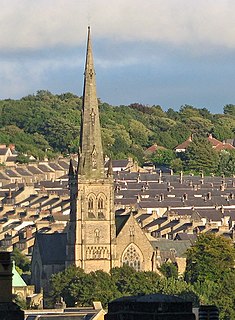
Lancaster Cathedral, also known as The Cathedral Church of St Peter and Saint Peter's Cathedral, is in St Peter's Road, Lancaster, Lancashire, England. It was a Roman Catholic parish church until 1924, when it was elevated to the status of a cathedral. It started as a mission church in 1798, and the present church was built on a different site in 1857–59. It was designed by E. G. Paley in the Gothic Revival style. In 1901 a baptistry was added by Austin and Paley, and the east end was reordered in 1995 by Francis Roberts. The cathedral is in active use, arranging services, concerts and other events, and is open to visitors. The building is recorded in the National Heritage List for England as a designated Grade II* listed building.

Lancashire is a county of England, in the northwest of the country. The county did not exist in 1086, for the Domesday Book, and was apparently first created in 1182, making it one of the youngest of the traditional counties.

Borwick is a village and civil parish in the City of Lancaster district of Lancashire, England, about 8 miles north of Lancaster, on the Lancaster Canal. It is situated just south of the border with Cumbria. Borwick had until 1960 a station on the former Furness and Midland Joint Railway now Leeds to Morecambe Line. The parish of Borwick had a population of 210 recorded in the 2001 census, decreasing to 181 at the 2011 Census.
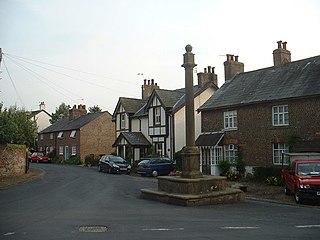
Kirkland is a civil parish, located on the banks of the River Wyre, midway between Preston and Lancaster, in the English county of Lancashire. It is also the historic name of what is now the village of Churchtown, within the parish. It is part of the Wyre district. In 2001 the parish had a population of 343, decreasing to 314 at the 2011 census.

The Storey, formerly the Storey Institute, is a multi-purpose building located at the corner of Meeting House Lane and Castle Hill in Lancaster, Lancashire, England. Its main part is recorded in the National Heritage List for England as a designated Grade II listed building, with its back entrance being listed separately, also at Grade II.

Over Kellet is a village and civil parish near Carnforth in the English county of Lancashire. The parish, which is in the City of Lancaster, includes the village of Capernwray, at its northern end, and has a population of 778, decreasing slightly to 761 at the 2011 Census. The Lancaster Canal passes through the parish.

Lancaster Priory, formally the Priory Church of St Mary, is the Church of England parish church of the city of Lancaster, Lancashire, England. It is located near Lancaster Castle and since 1953 has been designated a Grade I listed building. It is in the deanery of Lancaster, the archdeaconry of Lancaster and the Diocese of Blackburn. Its benefice is combined with that of St John and St Anne.

Claughton is a small village and civil parish in the City of Lancaster in Lancashire, England. The village is on the A683 road east of Lancaster and at the time of the 2001 census had a population of 132. In the 2011 census Claughton was grouped with Roeburndale to give a total of 223.

Hornby-with-Farleton is a civil parish in the City of Lancaster in Lancashire, England. It had a population of 729 recorded in the 2001 census, increasing marginally to 730 at the 2011 Census. The parish is about 8.5 miles (13.7 km) north-east of Lancaster and consists of two villages: Hornby and Farleton, both on the A683 road. The parish was formed 24 March 1887 from the parishes of "Hornby" and "Farleton".

St John the Evangelist's Church is a redundant Anglican church in North Road, Lancaster, Lancashire, England. It is recorded in the National Heritage List for England as a designated Grade II* listed building, and is under the care of the Churches Conservation Trust.

The former Lancaster Carriage and Wagon Works is located in Caton Road, Lancaster, Lancashire, England. The works produced railway rolling stock and trams. The buildings were designed by the local architect E. G. Paley. After the company moved its business elsewhere, the building was used during the First World War for the internment of enemy aliens. It is listed at Grade II, and, as of 2011, is in use as an office, warehouse and factory.
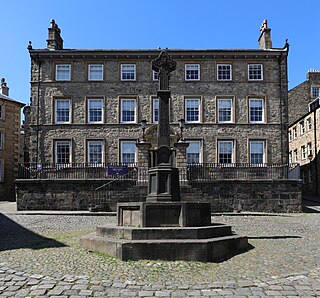
The Judges' Lodgings, formerly a town house and now a museum, is located between Church Street and Castle Hill, Lancaster, Lancashire, England. It is recorded in the National Heritage List for England as a designated Grade I listed building. The building is the oldest existing town house in Lancaster, and was also the first house in Lancaster to have shutters. It was used by judges when they attended the sessions of the Assize Court.

The first Lancaster railway station was the northern terminus of the Lancaster and Preston Junction Railway, located in the Greaves area of the city of Lancaster, Lancashire, England. It was open from 1840 to 1849, by which time it had been superseded by Lancaster Castle railway station. Some books refer to the station as "Lancaster (Greaves)" or "Lancaster " to distinguish it from later stations in the city, although whilst open it was known simply as "Lancaster" as there was no other station of that name at the same time.
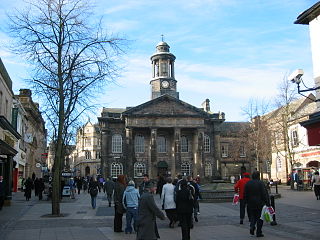
Lancaster City Museum is a museum in Lancaster, Lancashire, England. It is housed in the former Lancaster Town Hall building in Market Square.

The Custom House, Lancaster is a grade II* listed building located on St Georges Quay, Lancaster, Lancashire, England. The architect was Richard Gillow of the Gillow furniture making family. Designed in 1764 for the Port Commissioners, it was used for its original purpose until 1882 when the Customs were transferred to Barrow-in-Furness.

Lancaster Moor Hospital, formerly the Lancaster County Lunatic Asylum and Lancaster County Mental Hospital, was a mental hospital in Lancaster, Lancashire, England, which closed in 2000.
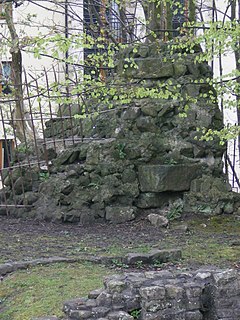
Lancaster Roman Fort, also known as Wery Wall, Galacum or Calunium, is the modern name given to ruined former Roman fort atop Castle Hill in Lancaster in North West England. The first castra was founded c. 80 AD within the Roman province of Britannia.